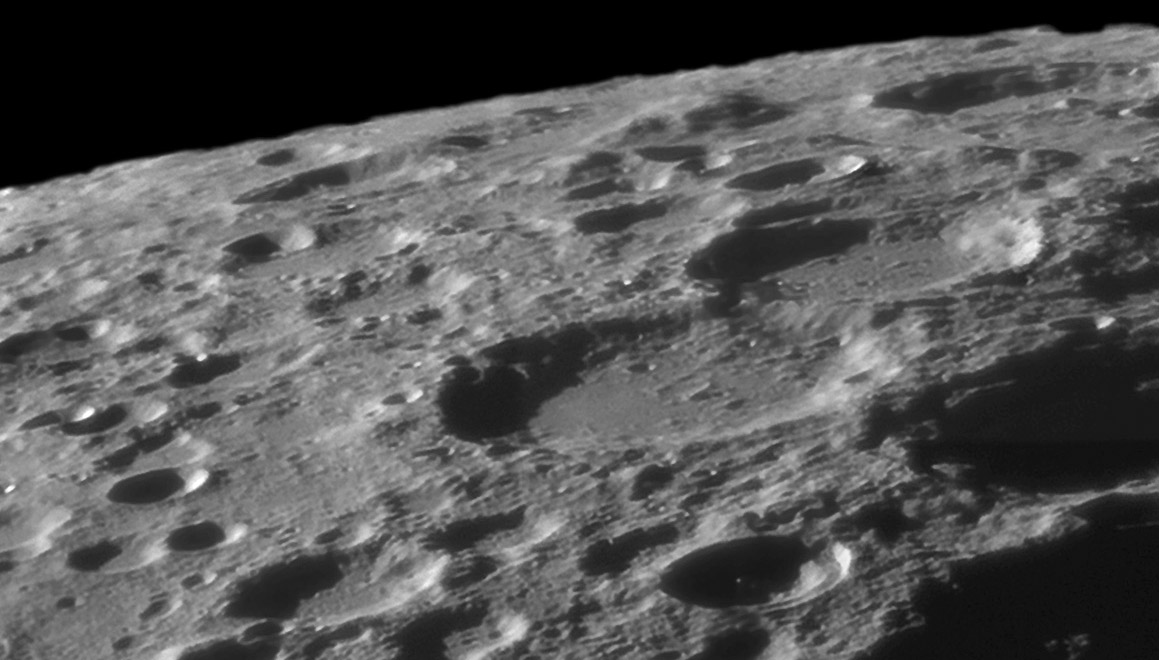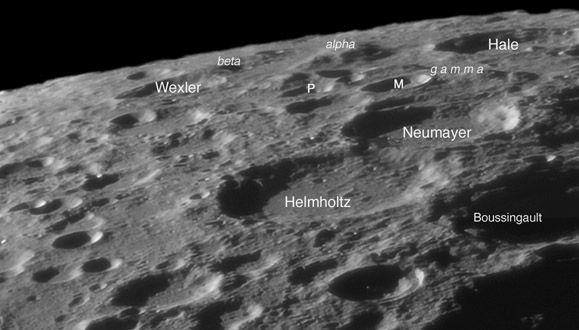|
|
| (2 intermediate revisions by the same user not shown) |
| Line 7: |
Line 7: |
| | <p>[[File:Southeastern-limb-lazz.jpg|southeastern-limb-lazz.jpg]]<br /> | | <p>[[File:Southeastern-limb-lazz.jpg|southeastern-limb-lazz.jpg]]<br /> |
| | <em>image by [mailto:paolo@lazzarotti-optics.com Paolo R. Lazzarotti], Florence, Italy</em></p> | | <em>image by [mailto:paolo@lazzarotti-optics.com Paolo R. Lazzarotti], Florence, Italy</em></p> |
| − | <p>At the end of the May 12 [http://www.lpod.org/?m=20070512 LPOD] that featured Ewen Whitaker’s classic map of the lunar south polar area I commented on the lack of good images showing the area just to the east, where the limb slopes towards Mare Australe. And the next day Paolo’s image appears with good libration and phenomenal sharpness and scale. This section of the southeast limb can now be explored from Earth. The deeply shadowed crater only partly seen at bottom right (south is up in this image) is Boussingault, with Helmholtz and Neumayer being the two broad and flat floored rings immediately to its east. Above Neumayer (actual direction is to the east) is Neumayer M, a fresh, sharp-rimmed crater, and zigging to the upper right from there is the large Copernicus-like crater Hale. With a diameter of 84 km Hale is the same size as Tycho - wonder if it has rays? - and is exactly on the limb at 90°. Due east of Hale is a large flat-topped mountain and continuing east is 52 km wide Wexler, whose rim lacks terraces. The most amazing feature in this scene is the large flat-topped mountain. I have had a pleasant time photocopying at 200% the maps of Mädler, Neison and the System of Lunar Craters, discovering that this huge massif does not appearon any of them. The mountain is drawn just on the left edge of Whitaker’s chart but he did not give it a designation. In the smaller image below I label this giant plateau Hale Alpha. Another mountainous ridge extends toward the farside from Wexler - making that crater look bigger - I call this ridge Hale Beta, and a third ridge (Hale Gamma) runs from behind Neumayer P and M and between Neumayer and Hale. On Clementine Atlas sheet 139 the horizontal extent of these can be seen, but their heights are not as apparent. These mountains may be part of the South Pole - Aitken Basin, but they are not in the same arc as most of the other Leibnitz Mountain basin rim. Congratulations Paolo on such a marvelously informative image!</p> | + | <p>At the end of the May 12 [[May_12,_2007|LPOD]] that featured Ewen Whitaker’s classic map of the lunar south polar area I commented on the lack of good images showing the area just to the east, where the limb slopes towards Mare Australe. And the next day Paolo’s image appears with good libration and phenomenal sharpness and scale. This section of the southeast limb can now be explored from Earth. The deeply shadowed crater only partly seen at bottom right (south is up in this image) is Boussingault, with Helmholtz and Neumayer being the two broad and flat floored rings immediately to its east. Above Neumayer (actual direction is to the east) is Neumayer M, a fresh, sharp-rimmed crater, and zigging to the upper right from there is the large Copernicus-like crater Hale. With a diameter of 84 km Hale is the same size as Tycho - wonder if it has rays? - and is exactly on the limb at 90°. Due east of Hale is a large flat-topped mountain and continuing east is 52 km wide Wexler, whose rim lacks terraces. The most amazing feature in this scene is the large flat-topped mountain. I have had a pleasant time photocopying at 200% the maps of Mädler, Neison and the System of Lunar Craters, discovering that this huge massif does not appearon any of them. The mountain is drawn just on the left edge of Whitaker’s chart but he did not give it a designation. In the smaller image below I label this giant plateau Hale Alpha. Another mountainous ridge extends toward the farside from Wexler - making that crater look bigger - I call this ridge Hale Beta, and a third ridge (Hale Gamma) runs from behind Neumayer P and M and between Neumayer and Hale. On Clementine Atlas sheet 139 the horizontal extent of these can be seen, but their heights are not as apparent. These mountains may be part of the South Pole - Aitken Basin, but they are not in the same arc as most of the other Leibnitz Mountain basin rim. Congratulations Paolo on such a marvelously informative image!</p> |
| | <p>[mailto:tychocrater@yahoo.com Chuck Wood]</p> | | <p>[mailto:tychocrater@yahoo.com Chuck Wood]</p> |
| − | <p><b>Technical Details:</b> 21 April 2007, 19:21-19:25 UT. Gladius CF-315 Lazzarotti Opt. telescope (f/25), Lumenera Infinity 2-1M camera, Edmund Optics R filter IR blocked, 120 frames stack out of 2000. This is a piece of Paolo’s larger original [[southeastern20070421_lazz.jpg|image]].</p> | + | <p><b>Technical Details:</b> 21 April 2007, 19:21-19:25 UT. Gladius CF-315 Lazzarotti Opt. telescope (f/25), Lumenera Infinity 2-1M camera, Edmund Optics R filter IR blocked, 120 frames stack out of 2000. This is a piece of Paolo’s larger original [http://www.lazzarotti-hires.com/images/moon/southeastern20070421_lazz.jpg image].</p> |
| | <p><b>Related Links:</b><br /> | | <p><b>Related Links:</b><br /> |
| | Rükl plates 75 and V<br /> | | Rükl plates 75 and V<br /> |
| | [http://www.lazzarotti-hires.com/ Paolo’s website] </p> | | [http://www.lazzarotti-hires.com/ Paolo’s website] </p> |
| − | <p><b>Yesterday's LPOD:</b> [[May 14, 2007|Your Own Moon]] </p>
| |
| − | <p><b>Tomorrow's LPOD:</b> [[May 16, 2007|Profile in Confusion]] </p>
| |
| | <div align="center"> | | <div align="center"> |
| | [[File:Southeastern-limb LPOD-names-sm.jpg|southeastern-limb LPOD-names-sm.jpg]]</div> | | [[File:Southeastern-limb LPOD-names-sm.jpg|southeastern-limb LPOD-names-sm.jpg]]</div> |
| | </div> | | </div> |
| | + | <p><b>Yesterday's LPOD:</b> [[May 14, 2007|Your Own Moon]] </p> |
| | + | <p><b>Tomorrow's LPOD:</b> [[May 16, 2007|Profile in Confusion]] </p> |
| | <p> </p> | | <p> </p> |
| | <p> </p> | | <p> </p> |





